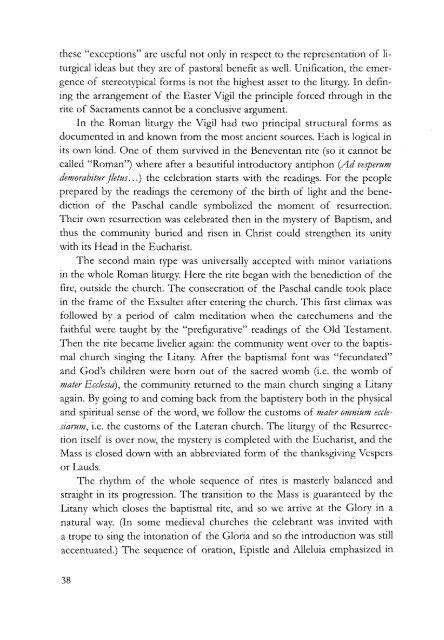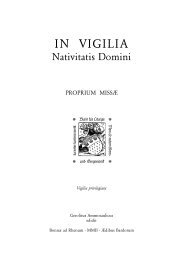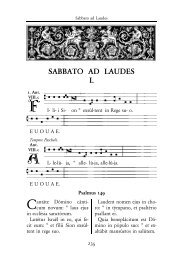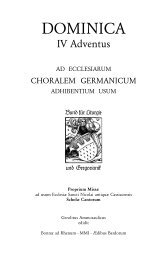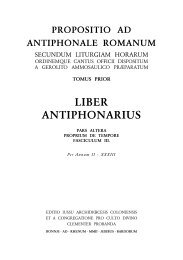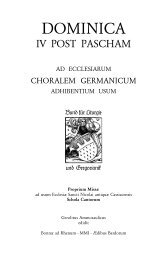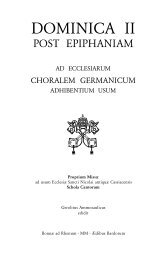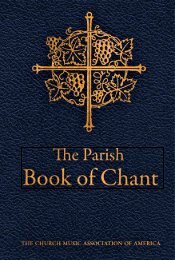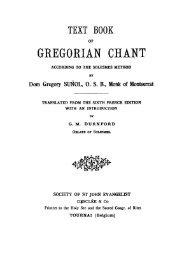The Bugnini-Liturgy and the Reform of the Reform - MusicaSacra
The Bugnini-Liturgy and the Reform of the Reform - MusicaSacra
The Bugnini-Liturgy and the Reform of the Reform - MusicaSacra
You also want an ePaper? Increase the reach of your titles
YUMPU automatically turns print PDFs into web optimized ePapers that Google loves.
<strong>the</strong>se "exceptions" are useful not only in respect to <strong>the</strong> representation <strong>of</strong> liturgical<br />
ideas but <strong>the</strong>y are <strong>of</strong> pastoral benefit as well. Unification, <strong>the</strong> emergence<br />
<strong>of</strong> stereotypical forms is not <strong>the</strong> highest asset to <strong>the</strong> liturgy. In defining<br />
<strong>the</strong> arrangement <strong>of</strong> <strong>the</strong> Easter Vigil <strong>the</strong> principle forced through in <strong>the</strong><br />
rite <strong>of</strong> Sacraments cannot be a conclusive argument.<br />
In <strong>the</strong> Roman liturgy <strong>the</strong> Vigil had two principal structural forms as<br />
documented in <strong>and</strong> known from <strong>the</strong> most ancient sources. Each is logical in<br />
its own kind. One <strong>of</strong> <strong>the</strong>m survived in <strong>the</strong> Beneventan rite (so it cannot be<br />
called "Roman") where after a beautiful introductory antiphon (Ad vesperum<br />
demorabitur fletus...) <strong>the</strong> celebration starts with <strong>the</strong> readings. For <strong>the</strong> people<br />
prepared by <strong>the</strong> readings <strong>the</strong> ceremony <strong>of</strong> <strong>the</strong> birth <strong>of</strong> light <strong>and</strong> <strong>the</strong> benediction<br />
<strong>of</strong> <strong>the</strong> Paschal c<strong>and</strong>le symbolized <strong>the</strong> moment <strong>of</strong> resurrection.<br />
<strong>The</strong>ir own resurrection was celebrated <strong>the</strong>n in <strong>the</strong> mystery <strong>of</strong> Baptism, <strong>and</strong><br />
thus <strong>the</strong> community buried <strong>and</strong> risen in Christ could streng<strong>the</strong>n its unity<br />
with its Head in <strong>the</strong> Eucharist.<br />
<strong>The</strong> second main type was universally accepted with minor variations<br />
in <strong>the</strong> whole Roman liturgy. Here <strong>the</strong> rite began with <strong>the</strong> benediction <strong>of</strong> <strong>the</strong><br />
fire, outside <strong>the</strong> church. <strong>The</strong> consecration <strong>of</strong> <strong>the</strong> Paschal c<strong>and</strong>le took place<br />
in <strong>the</strong> frame <strong>of</strong> <strong>the</strong> Exsultet after entering <strong>the</strong> church. This first climax was<br />
followed by a period <strong>of</strong> calm meditation when <strong>the</strong> catechumens <strong>and</strong> <strong>the</strong><br />
faithful were taught by <strong>the</strong> "prefigurative" readings <strong>of</strong> <strong>the</strong> Old Testament.<br />
<strong>The</strong>n <strong>the</strong> rite became livelier again: <strong>the</strong> community went over to <strong>the</strong> baptismal<br />
church singing <strong>the</strong> Litany. After <strong>the</strong> baptismal font was "fecundated"<br />
<strong>and</strong> God's children were born out <strong>of</strong> <strong>the</strong> sacred womb (i.e. <strong>the</strong> womb <strong>of</strong><br />
mater Ecc/esia), <strong>the</strong> community returned to <strong>the</strong> main church singing a Litany<br />
again. By going to <strong>and</strong> coming back from <strong>the</strong> baptistery both in <strong>the</strong> physical<br />
<strong>and</strong> spiritual sense <strong>of</strong> <strong>the</strong> word, we follow <strong>the</strong> customs <strong>of</strong> mater omnium ecclesiarum,<br />
i.e. <strong>the</strong> customs <strong>of</strong> <strong>the</strong> Lateran church. <strong>The</strong> liturgy <strong>of</strong> <strong>the</strong> Resurrection<br />
itself is over now, <strong>the</strong> mystery is completed with <strong>the</strong> Eucharist, <strong>and</strong> <strong>the</strong><br />
Mass is closed down with an abbreviated form <strong>of</strong> <strong>the</strong> thanksgiving Vespers<br />
or Lauds.<br />
<strong>The</strong> rhythm <strong>of</strong> <strong>the</strong> whole sequence <strong>of</strong> rites is masterly balanced <strong>and</strong><br />
straight in its progression. <strong>The</strong> transition to <strong>the</strong> Mass is guaranteed by <strong>the</strong><br />
Litany which closes <strong>the</strong> baptismal rite, <strong>and</strong> so we arrive at <strong>the</strong> Glory in a<br />
natural way. (In some medieval churches <strong>the</strong> celebrant was invited with<br />
a trope to sing <strong>the</strong> intonation <strong>of</strong> <strong>the</strong> Gloria <strong>and</strong> so <strong>the</strong> introduction was still<br />
accentuated.) <strong>The</strong> sequence <strong>of</strong> oration, Epistle <strong>and</strong> Alleluia emphasized in<br />
38


